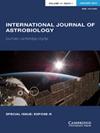天体生物学:用Maccone的对数正态方法在50步中解析统计Drake方程
IF 1
4区 物理与天体物理
Q3 ASTRONOMY & ASTROPHYSICS
引用次数: 0
摘要
作者使用Maccone的对数正态分布这一数学工具,将计算银河系中先进文明数量的德雷克方程从最初的7个层次进一步分解为49个层次的整体分析。事实上,在中心极限定理的支持下,Maccone方法引入的层次越多越可靠。由此产生的研究必然涉及一系列学科,从天文学、化学、地质学到生物学、古生物学和未来学。最后的结果计算出适合生命在不同发展阶段的行星系统的数量:那些在过去可能有生命存在的行星系统,以及那些在不同进化阶段仍有生命存在的行星系统。最后一个进化层次是所谓的银河文明(通常被称为ETC,或外星文明)。由此产生的星系文明的数量分为静态文明,它们不会在星系周围移动,其Kardašëv评级仍然很低(<1.4),我们发现了三个例子(我们自己加上,也许,另外两个),以及潜在的动态文明,它们在星系周围移动,并且具有足够高的Kardašëv评级(≥1.4),我们发现了2000个。本文章由计算机程序翻译,如有差异,请以英文原文为准。
Astrobiology: resolution of the statistical Drake equation by Maccone's lognormal method in 50 steps
The authors use the mathematical tool of Maccone's lognormal distribution to further factor the Drake equation, which calculates the number of advanced civilizations in the galaxy, from the seven original levels of the Drake equation to 49 levels of overall analysis. The Maccone approach, in fact, supported by the central limit theorem, becomes more reliable the more levels are introduced. The resulting study necessarily draws upon an array of disciplines ranging from astronomy, chemistry and geology to biology, palaeontology and futurology. The final result calculates the number of planetary systems suitable for life in its various stages of development: those which have probably hosted life in the past and those which still host it at its various evolutionary levels. The final evolutionary level is the so-called galactic civilization (often called ETC, or extraterrestrial civilizations). The number of resulting galactic civilizations is divided between static civilizations, which do not move around the galaxy and whose Kardašëv rating is still low (<1.4), of which we find three examples (we ourselves plus, perhaps, two others), and potentially dynamic civilizations, which move around the galaxy and have a sufficiently high Kardašëv rating (≥1.4), of which we find 2000.
求助全文
通过发布文献求助,成功后即可免费获取论文全文。
去求助
来源期刊

International Journal of Astrobiology
地学天文-地球科学综合
CiteScore
3.70
自引率
11.80%
发文量
45
审稿时长
>12 weeks
期刊介绍:
International Journal of Astrobiology is the peer-reviewed forum for practitioners in this exciting interdisciplinary field. Coverage includes cosmic prebiotic chemistry, planetary evolution, the search for planetary systems and habitable zones, extremophile biology and experimental simulation of extraterrestrial environments, Mars as an abode of life, life detection in our solar system and beyond, the search for extraterrestrial intelligence, the history of the science of astrobiology, as well as societal and educational aspects of astrobiology. Occasionally an issue of the journal is devoted to the keynote plenary research papers from an international meeting. A notable feature of the journal is the global distribution of its authors.
 求助内容:
求助内容: 应助结果提醒方式:
应助结果提醒方式:


